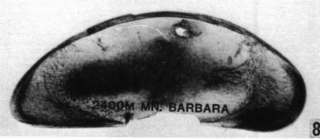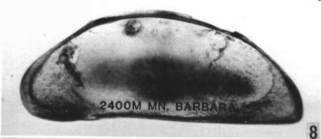WoRMS taxon details
Macrocyprina barbara Maddocks, 1990
460289 (urn:lsid:marinespecies.org:taxname:460289)
accepted
Species
marine, brackish, fresh, terrestrial
recent only
Maddocks, R. F. (1990). Living and fossil Macrocyprididae (Ostracoda). <em>University of Kansas Paleontological Contributions Monograph.</em> No 2: 1-285. [details]
Holotype USNM 2400M
Holotype USNM 2400M [details]
Etymology "Latin barbarus, strange, foreign; for the Santa Barbara Museum of Natural History, which collected and loaned the...
Etymology "Latin barbarus, strange, foreign; for the Santa Barbara Museum of Natural History, which collected and loaned the material." (Maddocks, 1990: 111) [details]
Brandão, S.N.; Antonietto, L.S; Nery, D.G.; Pereira, J.S.; Praxedes, R.A.; Santos, S.G.; Karanovic, I. (2024). World Ostracoda Database. Macrocyprina barbara Maddocks, 1990. Accessed through: World Register of Marine Species at: https://www.marinespecies.org/aphia.php?p=taxdetails&id=460289 on 2024-11-21
Date
action
by
![]() The webpage text is licensed under a Creative Commons Attribution 4.0 License
The webpage text is licensed under a Creative Commons Attribution 4.0 License
original description
Maddocks, R. F. (1990). Living and fossil Macrocyprididae (Ostracoda). <em>University of Kansas Paleontological Contributions Monograph.</em> No 2: 1-285. [details]
 Present
Present  Present in aphia/obis/gbif/idigbio
Present in aphia/obis/gbif/idigbio  Inaccurate
Inaccurate  Introduced: alien
Introduced: alien  Containing type locality
Containing type locality
Holotype USNM 2400M [details]
From editor or global species database
Comparison " Mn. barbara is much smaller than Mn. parcens but somewhat similar in shape and patch pattern; it is also a little more elongate posteriorly. Mn. swami and Mn. vargata are smaller but proportionally higher, with deeper ventral indentation, more highly arched dorsal margin, and three or more discrete opaque spots. Mn. barbara also differs from Mn. swami by its more elongate hemipenis with thinner, less conspicuous copulatory rod, and its larger, less sinuate male fifth limb." (Maddocks, 1990: 111) [details]Diagnosis " Carapace small, elongate, greatest height located slightly anterior to midlength; anterior margin broadly rounded and slightly truncate; ventral indentation very shallow; ventral margin sinuous, not upswung posteriorly; posterior angle broadly rounded, about 50° to 60°, not inflated, may be slightly truncate; central opaque pattern consists of a single, narrow, elongate patch.
Male fifth limbs very small, asymmetrical, rectilinear, with slender ventral pegs and short dorsal seta; distal hook short, rapidly tapering, curved at 87° in right limb and 125° in left limb. Dorsodistal claw of fifth limb about half as long as mediodistal claw. Recurved seta of seventh limb rather short, reaching only to middle of podomere II, lined with fine hairs that decrease in size distally. Furcae fairly robust, gracefully curved. Hemipen is elongate, tear-drop-shaped, with broadly rounded anterior margin; copulatory rod fairly short, straight. Zenker's organ with tiny terminal bulb; vas deferens arranged in four loops, as long as the Zenker's organ." (Maddocks, 1990: 111) [details]
Dimensions " Holotype specimen 2400M, RVL 1.06 mm, RVH 0.44 mm, LVL 1.03 mm, LVII 0.41 mm." (Maddocks, 1990: 111) [details]
Etymology "Latin barbarus, strange, foreign; for the Santa Barbara Museum of Natural History, which collected and loaned the material." (Maddocks, 1990: 111) [details]


